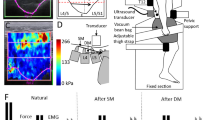Summary
The effect of two different load placements (just below mid-back or just above shoulder level) on erector spinae EMG, trapezius EMG, and heart rate were investigated during load carriage. The EMG and heart rates were telemetered from 11 subjects while they walked on a smooth level surface at an average velocity of 5.6 km·h−1 carrying a load of 19.5 kg in a specially designed backpack. The average rectified EMG amplitude was calculated digitally for both load placements. The high load placement resulted in significantly higher levels of muscle activity than did the lower placement. Heart rate was not significantly different between the two placements. A qualitative biomechanical analysis suggests that the EMG differences are primarily due to differences in the moments and forces arising from the angular and linear accelerations of the load and trunk. The results indicate that metabolic measures alone are not sufficient to adequately assess tasks which evoke primarily local muscle demands.
Similar content being viewed by others
References
Arsenault AB (1982) A variability study of EMG profiles in overground and treadmill walking in humans. Ph. D. Dissertation, University of Waterloo, Waterloo, Ontario, Canada
Bjelle A, Hagberg M, Michaelson G (1981) Occupational and individual factors in acute shoulder-neck disorders. Br J Ind Med 38: 356–363
Bobet J, Norman R (1982) Use of the average electromyogram in design evaluation: investigation of a whole-body task. Ergonomics 25: 1155–1163
Chaffin DB (1969) Physical fatigue: what it is — how it is predicted. J Methods-Time Measurement 14: 20–28
Chaffin DB (1973) Localized muscle fatigue — definition and measurement. J Occup Med 15: 346–354
Grainger J, Norman RW, Winter D, Bobet J (1983) Day-to-day reproducibility of selected biomechanical variables calculated from film data. In: Matsui H, Kobayashi K (eds) Biomechanics VIII-B, Human Kinetics, Champaign, Illinois pp 1239–1247
Winsmann FR, Goldman RF (1976) Methods for evaluation of loadcarriage systems. Percept Mot Skills 43: 1211–1218
Winter DA (1979) Biomechanics of human movement. John Wiley and Sons, Toronto
Author information
Authors and Affiliations
Rights and permissions
About this article
Cite this article
Bobet, J., Norman, R.W. Effects of load placement on back muscle activity in load carriage. Europ. J. Appl. Physiol. 53, 71–75 (1984). https://doi.org/10.1007/BF00964693
Accepted:
Issue Date:
DOI: https://doi.org/10.1007/BF00964693




